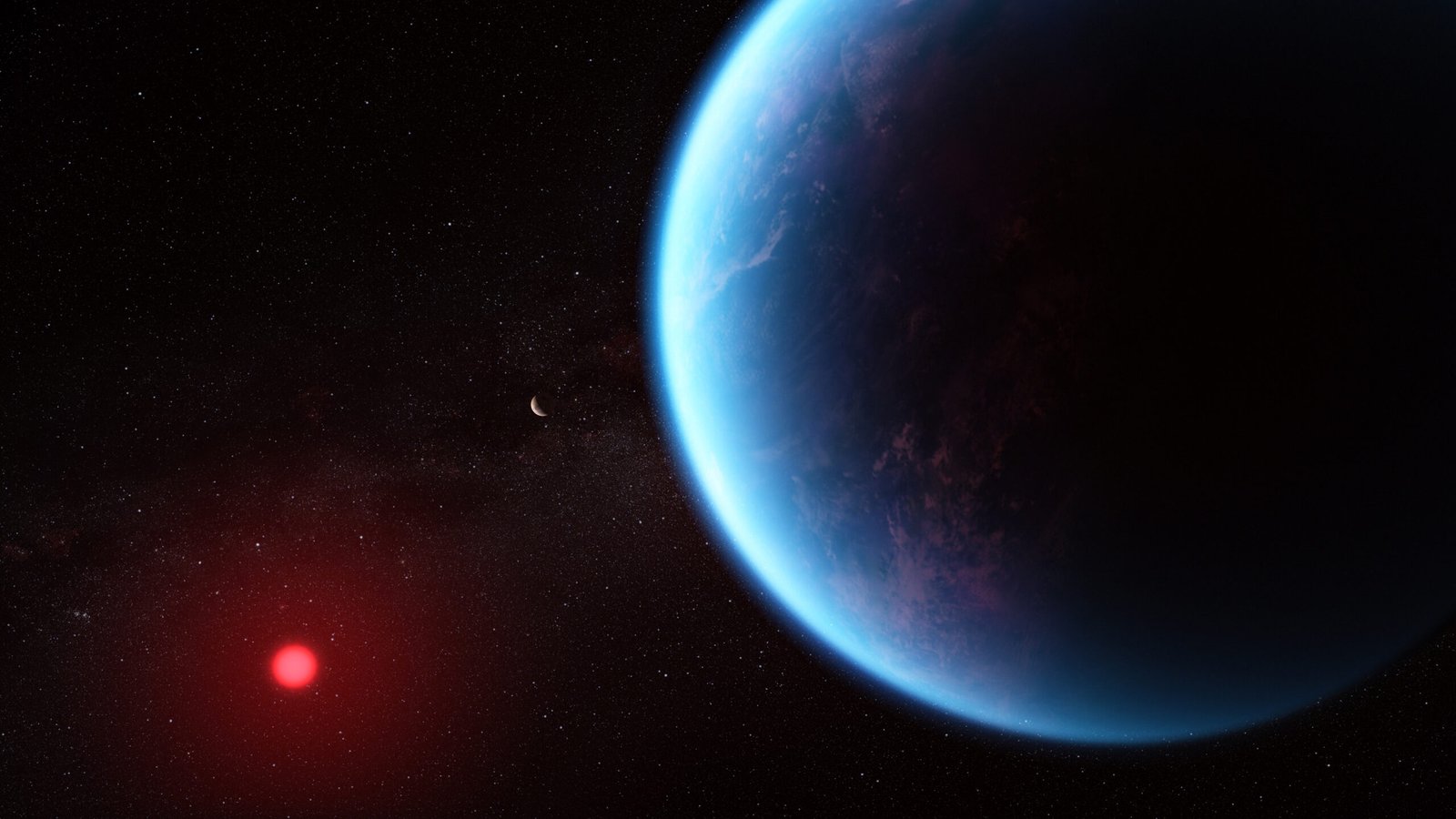In April 2025, the scientific community was abuzz after discovering a planet that could harbor life. The age-old question, ‘Are we alone in the universe?’ has sparked curiosity in scientists and regular folks alike.
Using the incredibly powerful James Webb Space Telescope (JWST), scientists detected compounds in the atmosphere of exoplanet K2-18b, specifically dimethyl sulfide (DMS) and dimethyl disulfide (DMDS).
K2-18b is located about 124 light years away in the habitable zone of a red dwarf star. It is classed as a ‘Hycean’ planet, which means a world with a hydrogen-rich atmosphere and potential global oceans.
Why is this important?
Well, on Earth, these compounds are produced by marine microorganisms like phytoplankton. Get this: the scientists are 99.7% sure that these molecules are what they detected, but there is a catch, and it is an interesting one.
Before you get carried away thinking about alien civilizations, let’s unpack this.
![The graphic shows the spectra of the exoplanet K2-18 b from NIRISS and NIRSpec in the form of a graph, with the vertical y-axis labelled as Amount of Light Blocked and the horizontal axis labelled as Wavelength of Light (microns). The spectra is plotted as dots with vertical short vertical lines across the plot, with the best-fit model as a blue jagged white line.There are green, yellow and light blue vertical columns of varying thicknesses scattered across the plot indicating where variations in the line represent the presence of methane, carbon dioxide, and dimethyl sulphide, respectively. Behind the graph is an illustration of the planet and star.]](https://boredkiwi.com/wp-content/uploads/2025/04/Exoplanet_K2-18_b_Atmosphere_Composition-1024x576.jpg)
Illustration: NASA, CSA, ESA, R. Crawford (STScI), J. Olmsted (STScI), Science: N. Madhusudhan (Cambridge University)
How does a telescope see what is in an atmosphere 124 light years away?
That’s like 1.17 quadrillion kilometers away (about 1.1 million billion km).
What is a quadrillion? It’s a very big number, I’ll tell you that much.
JWST is equipped with the hardware to analyze light passing through the atmospheres of faraway planets. The light picks up on the chemical signature of molecules in the atmosphere it passes through, allowing us to tell things apart.
The details are then surfaced by splitting the light into its frequencies, much like how a prism creates a rainbow from white light. If some parts of the expected spectrum are missing, it is because they were absorbed by the chemicals in the planet’s atmosphere, which tells you its composition.
I mean, it’s impressive stuff.
A search for marine life signatures

Zina Deretsky/National Science Foundation
You have probably at some point seen this image of the sea creature Tiktaalik when our ancestors left the ocean and made it onto land, or heard of scientists talking about the primordial soup that created life.
The point is, oceans (or watery places) are where scientists think life tends to start, take hold, and is most abundant. It stands to reason that if we were to find something, these compounds would be one of the signatures to watch out for.
This recent research, led by Professor Nikku Madhusudhan of the University of Cambridge, expressed shock at the results his team saw, saying, “On Earth, DMS is only produced by life. The bulk of it in Earth’s atmosphere is emitted from phytoplankton in marine environments.”
The presence and amounts of CO2 and methane in the atmosphere seem to point to a water ocean under a hydrogen-rich atmosphere. Previously, the Hubble telescope had detected possible water vapor, which is why K2-18b was one of the first planets JWST studied.
99.7% sure sounds like a lot, but in science, it kinda isn’t
Scientifically speaking, you need to be 99.9999% sure that the results are correct and not a misreading of some kind. Scientists call this a ‘five sigma’ result. The latest results that have sparked this story, at 99.7%, are only three sigma.
Yeah, it gets very serious in the world of science before you can claim a discovery. Even with a five-sigma result, it won’t be conclusive proof of life, and we still can’t send anyone there to check anytime soon.
So, what else could it be?
Abiotic (not related to living organisms) processes could produce similar compounds. For example, photochemical reactions in a planet’s atmosphere could create DMS without the presence of life.
Other interpretations say K2-18b could be a gas-rich mini-Neptune with no habitable surface. The observed methane and carbon dioxide could be from thermochemical processes in the planet’s deep atmosphere.
Powerful as JWST is, it can’t zoom in that close.
If it is life…

If the results are confirmed, Prof Madhusudhan says that it should confirm that life “is very common in the galaxy,” which is exciting stuff.
The Fermi Paradox, which discusses the contradiction of being in a universe so abundant with planets and yet so seemingly devoid of other life, remains unsolved.
As we continue to explore, it is always good to balance your excitement with some skepticism. Check back in on this story in one or two years when they take another look as the planet circles back into view on its orbit.
Before you go, have you ever wondered what would happen if we did find life? What if it is sentient? What if it wants to visit? Find out, in my coverage of “Maybe You Don’t Want Aliens To Visit.”













This is great and informative,love it!!!
Thank you Kim. Hoping to write more of the same across diverse topics.